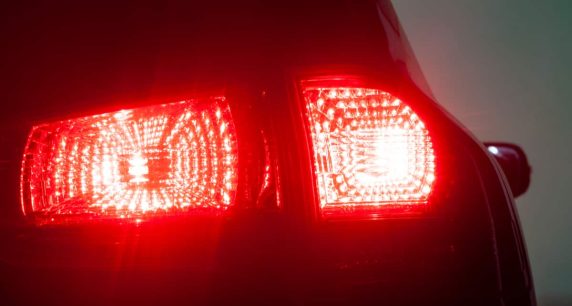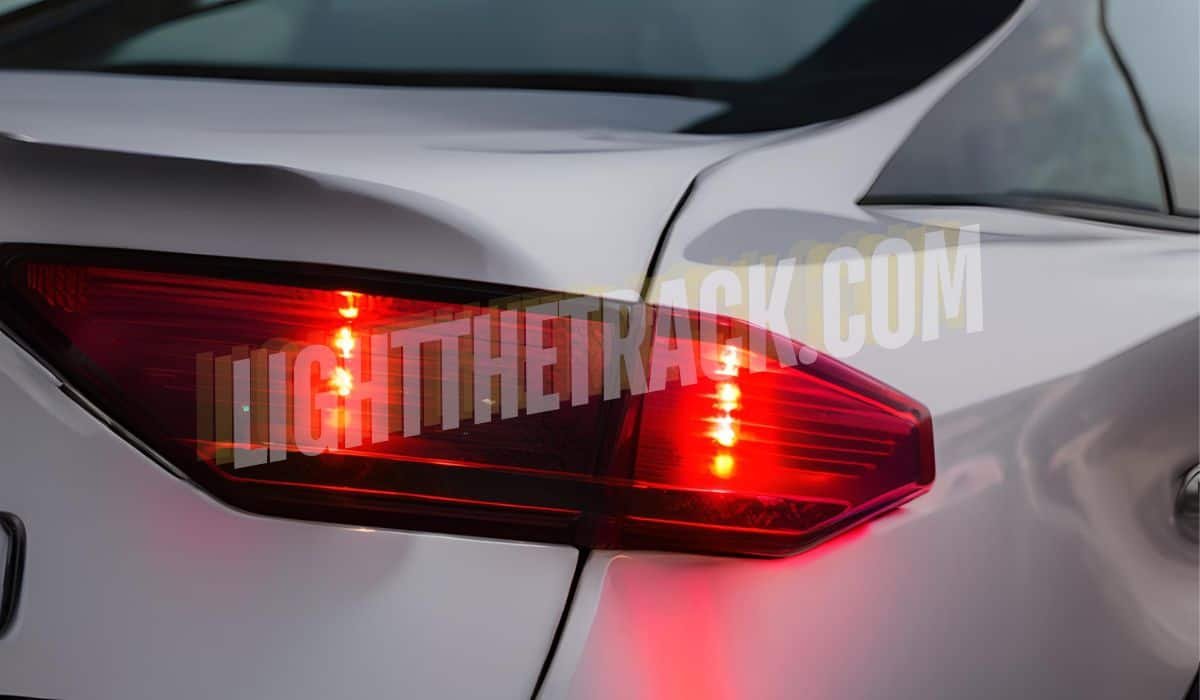Brake light issues can be frustrating, especially when the light stays on even after releasing the brake pedal. Some common signs that your brake light may be faulty include:
- The light staying on after releasing the brake pedal
- The brake pedal feeling spongy
- The brakes not responding as expected
Initial diagnostics to consider include checking the brake fluid level, inspecting the brake pads, and examining the brake light switch. A stuck brake pedal is the most common cause of brake lights not turning off. To fix this issue, you can try:
- Releasing the pedal with your hand or foot
- Lubricating the pedal mechanism
- Adjusting the brake pedal switch
If these solutions do not work, it may be necessary to replace the brake light switch or seek the help of a professional mechanic.
May you like: What Causes Flickering Lights

Credit: www.gmride.com.my
The Role Of The Brake Light Switch
If your brake light stays on, it could be due to a bad brake light switch. The brake light switch is responsible for turning the brake lights on and off as you press or release the brake pedal. A faulty switch can cause the brake lights to stay on constantly or not come on at all. Common symptoms of a bad brake light switch include:
- Constant illumination of the brake lights even when the pedal is not pressed
- Failure of the brake lights to illuminate when the pedal is pressed
If you are experiencing these issues, it may be time to inspect and potentially replace the brake light switch to ensure proper functioning of your brake lights.
Brake Light Switch Grommet Explained
When it comes to understanding why your brake light stays on, it’s important to look at the brake light switch grommet. This small rubber component can become worn-out over time, causing the brake light to stay illuminated even when the brakes are not engaged.
Identifying a worn-out grommet is relatively easy. Simply inspect the grommet for any signs of damage or wear. If it appears cracked, torn, or brittle, it’s likely time for a replacement.
To replace the grommet, follow these steps:
- Locate the brake light switch, usually near the top of the brake pedal.
- Disconnect the battery to ensure safety.
- Remove the old grommet by gently pulling it off the switch.
- Install the new grommet by pushing it onto the switch until it is securely in place.
- Reconnect the battery and test the brake light to ensure it no longer stays on.
By replacing the brake light switch grommet, you can prevent your brake light from staying on unnecessarily and ensure proper functioning of your brake system.
May you need: California LED Headlight Laws
Electrical System Troubleshooting
When troubleshooting an electrical system for a brake light that stays on, it is important to inspect for electrical malfunctions. Start by checking the brake light switch grommet to see if it is damaged or worn out. The grommet should be in good condition and properly installed. Additionally, test the float contact of the brake fluid reservoir and inspect the behavior of the brake pad wear indicator. If necessary, replace the wear sensor. Checking for blown fuses and installing a new brake light switch can also help resolve the issue.
It is important to note that if the brake service warning light is always on, it may indicate a need for parking brake adjustment, worn brake pads, or hydraulic issues. If the brake light comes on while driving, it could be due to low brake fluid, a stuck emergency brake, problems with the ABS unit, or sensor issues. Lastly, if the brake lights remain on even when the car is off, it could be a result of a stuck brake pedal.
Brake Pedal Position And Sensor Issues
If you’re wondering why your brake light stays on, it could be due to issues with the brake pedal position and sensor. This problem is often caused by a faulty brake light switch or sensor, as well as potential malfunctions in the electrical system.
It’s important to address this issue promptly to ensure your safety on the road.
Brake Pedal Position and Sensor Issues
When your brake light stays on, it could be due to various reasons such as sensor issues or problems with the brake pedal position. Adjusting the brake pedal for proper clearance can be one solution to this issue. If the problem is related to the sensor, then checking the brake light switch grommet is important. Keeping the brake lights in good condition is crucial as it helps in avoiding accidents on the road.
Sensor-related problems and solutions
If the brake light stays on, it could be due to sensor-related issues. One solution is to disconnect the battery. Another solution is to check the brake light switch for damage and install a new one if necessary. Replacing blown fuses could also be helpful. If the brake service warning light is always on, it could be due to worn brake pads or hydraulic issues. On the other hand, if it turns on when you hit the pedal, it could be due to hydraulic loss on one side of your vehicle or low brake fluid in the master cylinder.
Credit: www.quora.com
The Importance Of Correct Bulb Installation
Proper bulb installation is crucial for ensuring the correct functioning of your brake light. If your brake light stays on, it could be a sign of a faulty brake light switch, sensor, or electrical system malfunction. Checking and fixing these components is important to maintain road safety.
When replacing brake light bulbs, ensure proper installation to prevent issues:
- Incorrect bulb fitting can lead to brake light malfunction, affecting road safety.
- Proper bulb replacement is crucial for ensuring optimal brake light performance.
Fuse Box Inspection
If your brake light stays on, it could be due to a faulty fuse box. Check the fuse box for any blown fuses that might be causing the issue. A thorough inspection of the fuse box can help determine if it’s the source of the problem.
When checking why your brake light stays on, start by inspecting the fuse box:
- Locate the fuse box in your vehicle and assess the condition of the fuses.
- If you find any blown fuses related to the brake lights, consider replacing them.
Parking Brake Adjustment And Indicators
If your brake light stays on, it could be due to a need for parking brake adjustment or worn brake pads. It could also be caused by hydraulic issues or a malfunction in the electrical system. Checking the brake light switch for damage, installing a new switch, or replacing blown fuses can help fix the issue.
When the brake light stays on, it could indicate various issues:
- Checking the parking brake status is crucial to identify the problem.
- Make sure parking brake adjustment is done correctly to avoid light issues.
- If the brake light stays on while driving, it may signal hydraulic loss.
Resolving these issues promptly is essential for vehicle safety.
When To Seek Professional Help?
If your brake light stays on, it may indicate a problem with the brake light switch or sensor, a faulty brake pedal, or an electrical system malfunction. Seeking professional help is recommended to diagnose and fix the issue properly.
- Identifying complex brake light problems.
- Finding a reputable mechanic for brake systems.
- Look for professional help if the brake light stays on.
- Reputable mechanics can diagnose and fix the issue.
- Avoid DIY if the problem seems complex or uncertain.
- Seek expertise for safety and proper repair.
Maintenance Tips To Prevent Future Issues
Regular maintenance checks are essential to keep your brake system healthy and prevent future issues. It is recommended to check your brake light regularly to ensure it is working correctly. If your brake light stays on, it could indicate a problem with the brake system.
To prevent future issues, here are some best practices for brake light care:
- Check the brake light regularly to ensure it is working correctly.
- Regularly inspect the brake system for any leaks or damage.
- Ensure brake fluid is at the recommended level.
- Check brake pads and rotors for wear and replace as needed.
- Have your brake system inspected by a professional if you notice any issues.
Read more: Ballast Necessity for LED Headlights
Frequently Asked Questions
How Do You Fix A Brake Light That Stays On?
To fix a brake light that stays on, first check the brake pedal for any sticking issues. If the pedal is not returning fully, it could be the cause. Next, inspect the brake light switch for any damage. If needed, replace the switch or check for electrical system malfunctions.
What Does It Mean When Brake Light Stays On?
When the brake light stays on, it could indicate a faulty brake light switch or sensor. It may also be caused by a stuck brake pedal or an electrical system malfunction. This issue can lead to drained batteries or brake light burnout. Check for these common causes to fix it.
Why Is My Brake Light On But Brakes Work Fine?
The brake light may stay on due to a faulty brake light switch, a stuck brake pedal, or a malfunction in the electrical system. It’s important to address this issue promptly to ensure proper functionality and safety of the brake system.
Why Are My Brake Lights Still On When The Car Is Off?
The most common cause for brake lights staying on when the car is off is a stuck brake pedal. If the pedal doesn’t fully retract, it keeps the lights on. It could also be due to a faulty brake light switch or sensor.
Why Do My Brake Lights Stay On?
There are a few reasons why your brake lights may stay on, such as a faulty brake light switch or sensor, a stuck brake pedal, or hydraulic issues.
How Do I Fix A Brake Light That Stays On?
To fix a brake light that stays on, you can try checking the brake light switch for damage, installing a new brake light switch, or replacing blown fuses.
What Does It Mean When The Brake Light Stays On?
When the brake light stays on, it could indicate low brake fluid, a need for parking brake adjustment, hydraulic loss on one side of your vehicle, or a problem with the ABS unit or sensors.
Conclusion
A brake light that stays on can be caused by various issues such as a faulty brake light switch, worn brake pads, hydraulic problems, or even a malfunction in the electrical system. It’s crucial to address this problem promptly to ensure safety on the road. Regular maintenance and timely repairs can help prevent such issues in the future.


Leave a Reply